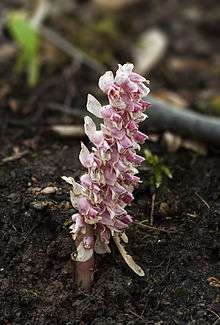Lathraea squamaria
Lathraea squamaria, the common toothwort, is a species of toothwort. It is widely distributed in Europe and also occurs in Turkey.
| Lathraea squamaria | |
|---|---|
 | |
| Scientific classification | |
| Kingdom: | Plantae |
| Clade: | Tracheophytes |
| Clade: | Angiosperms |
| Clade: | Eudicots |
| Clade: | Asterids |
| Order: | Lamiales |
| Family: | Orobanchaceae |
| Genus: | Lathraea |
| Species: | L. squamaria |
| Binomial name | |
| Lathraea squamaria | |

It is parasitic on the roots of hazel and alder, and occasionally other trees, and represents the second occasion on which a member of the Orobanchaceae family lost the ability to photosynthesize and became parasitic.[1] It occurs in shady places such as deciduous woodland and hedge sides. The plant consists of a branched whitish underground stem closely covered with thick, fleshy, colourless leaves, which are bent over so as to hide under the surface. The only portions that appear above ground in April to May are the short flower-bearing shoots, which bear a spike of two-lipped dull purple flowers, but is also able to produce cleistogamic underground flowers which fertilise themselves. It is also able to regenerate from broken fragments of the underground stem.[2]
Description
Toothwort is a perennial plant producing clumps of flowering shoots in late spring. The low, hairy, creamy-pink flowering shoot grow in a one-sided spike to a height of 3 to 9 in (8 to 23 cm). The few scales on the stem represent the leaves, but the whole shoot is devoid of chlorophyll. The individual pinkish flowers are drooping and have short stalks, two lips and open mouths. The calyx teeth are blunt and hairy.[3] The scales which represent the leaves also secrete water, which escapes and softens the ground around the plant. Externally they immediately reveal their heterotrophic character by their lack of chlorophyll and the reduction of their leaf area.[2]
Distribution and habitat
Common toothwort is widely distributed throughout Europe, its range extending from France and Norway to Russia, Bulgaria, Italy and Greece.[4] In the British Isles, it is found in England and Northern Ireland, and less often in lowland areas of East England, Southwest England, Wales, Scotland and the Republic of Ireland. Its natural habitats are deciduous woodland, hedgerows and the banks of rivers and streams.[5] It grows in Hatherton Flush, an SSSI in Cheshire.[6]
References
- Samigullin, Tahir H.; Logacheva, Maria D.; Penin, Aleksey A.; Vallejo-Roman, Carmen M. & Robinson-Rechavi, Marc (2016). "Complete plastid genome of the recent holoparasite Lathraea squamaria reveals earliest stages of plastome reduction in Orobanchaceae". PLOS One. 11 (3): e0150718. Bibcode:2016PLoSO..1150718S. doi:10.1371/journal.pone.0150718. PMC 4775063. PMID 26934745.
- Groom, Percy (1897). "On the leaves of Lathraea Squamaria and of some allied Scrophulariaceae". Annals of Botany. 11 (43): 385–398. JSTOR 43234288.
- McClintock, David & Fitter, R.S.R. (1961). The Pocket Guide to Wild Flowers. London: Collins. p. 148.
- "Lathraea squamaria". Flora Europaea. Retrieved 16 March 2020.
- "Lathraea squamaria". Online Atlas of the British and Irish Flora. Retrieved 16 March 2020.
- Hatherton Flush (PDF), Natural England, retrieved 16 March 2020